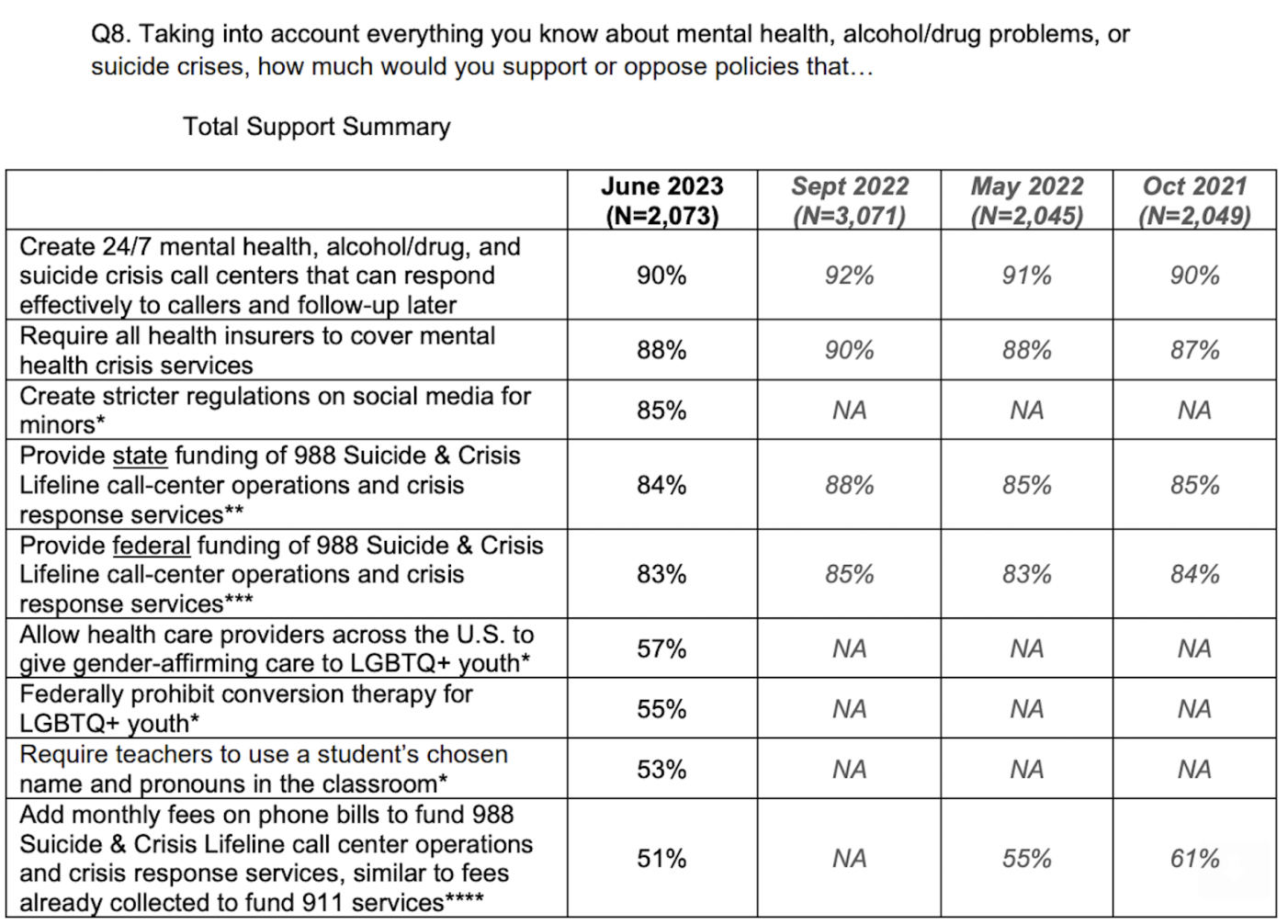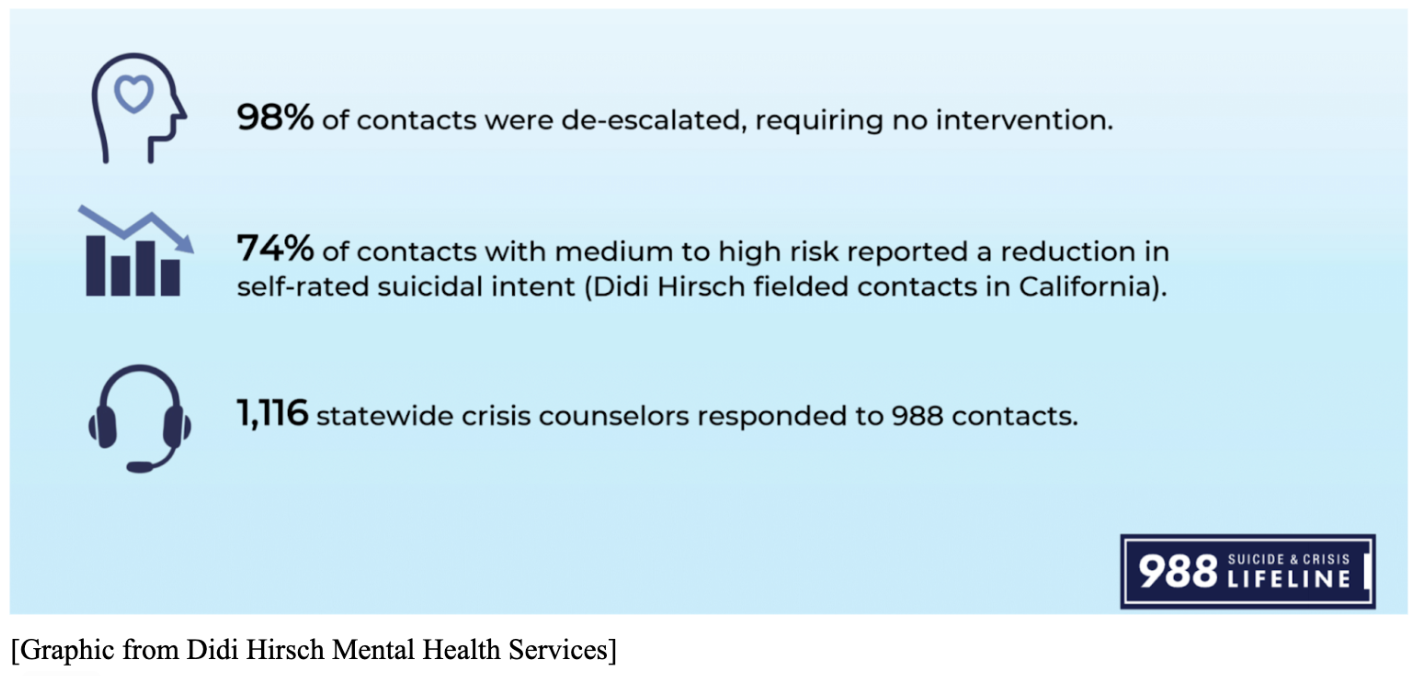9-8-8 Turns One. Here’s What You Need To Know.
The 9-8-8 Lifeline launched one year ago with a vision of providing “24/7, free and confidential support for people in distress, prevention and crisis resources for you or your loved ones, and best practices for professionals in the United States.” For mental health professionals and advocates, 9-8-8 is a critical part of a broader mission to provide everyone in crisis with someone to call (e.g. 9-8-8), someone to respond (e.g. a mobile crisis unit), and somewhere to go (e.g. a crisis stabilization center).
Here’s how things are going so far—with snapshots from the national, state, and local levels:
1. ACROSS THE COUNTRY
Call Volume Way ; Wait Time Cut Way : CNN’s Jacqueline Howard and Giri Viswanathan reported that 9-8-8 operators handled “nearly 5 million calls, texts and online chat messages” over the past year, citing data from the US Department of Health and Human Services. That represents a “1,135% [increase in] chats answered increased by 141% and calls answered increased by 46%, according to the HHS data. The average speed to answer for contacts decreased from 2 minutes and 39 seconds to 41 seconds.”
Related: ABC News reports that “the lifeline also offers services specific to military veterans with a link to the Veterans Crisis Line. Approximately 1 million out of the 5 million contacts received in the last year were for the veteran's line, according to SAMHSA.”9-8-8’s Biggest Challenge—And Opportunity: “Only 18% of adults in the U.S. are aware of 988, according to a survey released in May by the Pew Charitable Trusts,” which is why “local and national 988 leaders” told NPR’s Ryan Levi and Dan Gorenstein that “raising awareness has become their top priority.”
NEW NAMI POLL: Voters overwhelmingly support a mental health—not police—led response to mental health related calls for service. Here are three key points from the National Alliance on Mental Illness (NAMI) poll:
Among a list of nine policy options, voters showed the most support for creating a “24/7 mental health, alcohol / drug, and suicide crisis call center that can respond effectively to callers and follow-up later”
By a 73 point margin, voters said that “when someone is in a mental health or suicide crisis” they “should receive a mental health response” as opposed to a “police response.”
By a 43 point margin, voters said they’d be “more likely” to call 988 for themselves or another person if “health care professionals would arrive to the scene of the crisis first” instead of if “police would arrive … first.”
2. IN THE STATES
California. For California Public Radio, Kate Wolffe reports that “aggregated data from California’s crisis response centers show calls are up 28% since the easy-to-remember number went into operation. According to officials with Didi Hirsch Mental Health Services, the state’s largest crisis response center, only 2% of calls require intervention … The majority, 98%, are resolved on the phone by trained counselors.” Moreover, “interacting with 988 counselors does seem to be lowering suicidality among contacts.”
Nebraska: For KETV, Omaha’s local ABC affiliate, Sarah Klinge reports that “[s]ince 988 Nebraska's implementation [the number of calls to the crisis hotline] has more than doubled.” Despite the vast increase in call volume, “the [local] answer rate is 95.53%, exceeding the initial goal of 90%” set when 9-8-8 launched a year ago. The Nebraska Department of Health and Human Services “said more than 96% of calls are being de-escalated by crisis counselors without having to activate the Mobile Crisis Response Team.”
Virginia: For The Center Square, Morgan Sweeney reports that Virginia is “one of 14 states leading the country with [local] call answer rates between 90 and 98%.” Meanwhile, “Virginia’s call volume was the second-largest among the 14, with 11,688 calls in the last year and a call answer rate of 92.3%” and an “average wait time of about 20 seconds.” Experts attribute some of Virginia’s outlier success to the fact that the Commonwealth “is one of only six states that have enacted legislation to fund crisis services through telecom fees.”
3. A Notable Example From One Of America’s Most Populous Cities.
For WHYY, Philadelphia’s public radio station, Nicole Leonard reports on the city’s effort to realize the broader vision behind 9-8-8’s launch—someone to call, someone to respond, and somewhere to go. Last year, “the city hired more staff and professional counselors at its crisis call centers to handle rising demand for services, and now have civilian experts embedded in 911 dispatch centers to better identify behavioral health crisis calls and send appropriate care.”
Meanwhile, “calls to 988 in Philadelphia in 2022 jumped 14% [while] mobile crisis unit dispatches were up 37%.” And the “city plans to open a fifth Crisis Response Center, [which will] take mental health and substance use-related emergency cases, perform evaluations, and link people to medication assisted treatment and other services.”
And “the city is working on a long-term crisis stabilization team or assistance service that could provide people with up to six weeks of follow up care after an initial crisis, “to prevent reemergence of a crisis.”




